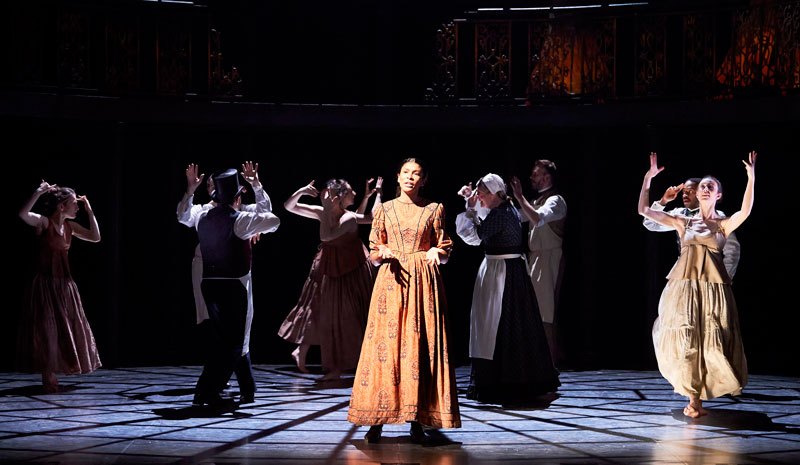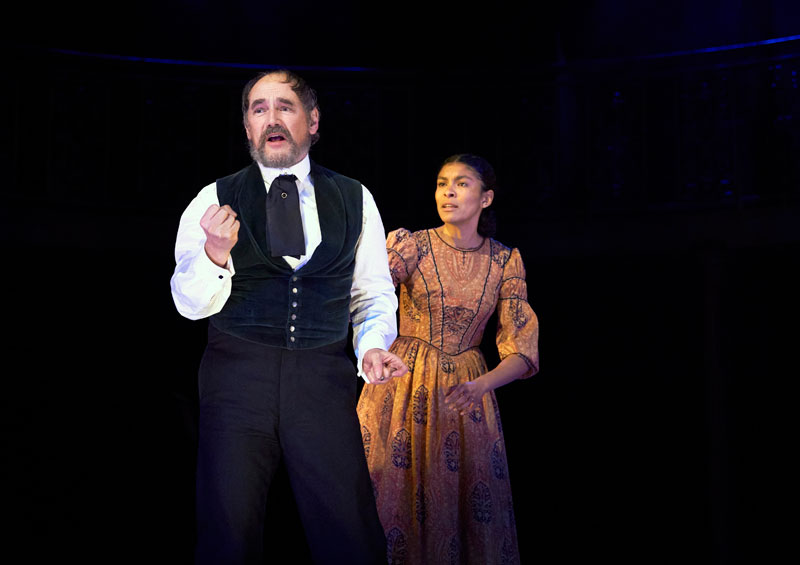After almost two years in the making, the powerful world premiere production of Dr Semmelweis has finally made it to the stage at Bristol Old Vic, immortalising the lives of everyone involved in a journey of discovery. To find out more, we chat to the production’s narrator, Maria Semmelweis, played by the abundantly talented Thalissa Teixeira…
If you haven’t heard by now, world-renowned actor, playwright and theatre director Sir Mark Rylance has teamed up with fellow writer Stephen Brown (Occupational Hazards) and artistic director of Bristol Old Vic, Tom Morris OBE (War Horse, Touching the Void), to tell the story of Dr Ignaz Semmelweis – a 19th century Hungarian physician who discovered the cause of puerperal ‘childbed’ fever and introduced antiseptic procedures into medical practice.
His discovery at the time, however, although blindingly obvious to us in 2022, especially as we come through a global pandemic, was fiercely rejected by medical professionals who refused to believe that their unwashed hands had been the prime cause of thousands of deaths. Pushed aside and labelled as a radical, controversial practitioner, the traduced genius spent the rest of his life haunted by the faces of those who had needlessly suffered, and tortured by the fact that many more were still dying despite his findings. Driven to an eventual breakdown, he died a pariah at the tender age of 47 in an asylum. For decades, his life’s work lay buried in the annals of history.
You can’t just be – as Mark [Rylance] says, using a great metaphor – fed with a knife, you’ve got to use a spoon and a fork to gently bring information to people’s mouths otherwise it’s going to be rejected
Although Semmelweis is now very much celebrated as ‘the father of hand hygiene’ – and the recent world-altering events have given currency to his name once again – it is thanks to Rylance, Brown and Morris that not only his life but those of his wife and allies are immortalised in performance, all of whom have purpose, point, and place in this narrative. What’s more, through their stories, issues of class, race and gender discrimination are addressed and explored. It’s been 175 years since Semmelweis first mandated hand-washing across his department in one of Vienna’s free institutions for underprivileged women – and science has made huge advancements since – but sadly, as we live through another worldwide health crisis, the same inhumanity and lack of care for certain groups of people remain evident. As we come to learn, the creators of Dr Semmelweis were not willing to let such observations go unheeded.
Eager to discover more about Semmelweis’s extraordinary life, we thought it fitting to speak to the person in charge of guiding the production’s narrative – his wife, Maria – played by the incredibly talented Thalissa Teixeira (Fast & Furious Presents: Hobbs & Shaw, The Musketeers, We Met Before). As Thalissa takes a mid-morning break from rehearsals, she sits down with us, her voice echoing around the great hall of the Bristol Old Vic, and lets us in on a play to remember.

“I suppose you could say that this is just a play about the discovery of handwashing,” she begins. “But actually there are so many questions in there. We’ve had a lot of conversations about if it was a rich, upper class sector of Vienna, would they have come up with a solution a lot sooner. Unfortunately, we had to do a lot of shifting when the pandemic happened – we couldn’t end it with ‘oh hurrah, this one guy has come up with a really positive thing andyou wash your hands and everything’s fine’, it’s actually about addressing the class system, what’s going on with race and who suffers the most when the NHS funding gets cut. I think the play isn’t about saying ‘all these women are dying, we had no idea’ – they had the figures – it was just about who was bothered to do something about it and what price did they have to pay to make those advancements. It is, of course, celebratory – it’s an amazing discovery – but the societal issues have made such small advancements. The play is about science versus care, home versus discovery, and who gets left behind along the way.”
Dr Semmelweis is set over one night in Vienna in the year 1860, five years before his death. He has been shunned by the profession and is clearly struggling with post-traumatic stress disorder. Maria is pregnant with the first of her five children, which stirs Semmelweis’s memories of the women who died in childbirth. It should be said at this point that Semmelweis, although intrinsic to the nascent growth of evidence-based medicine, certainly played a part in his own downfall. Outspoken, angry, violent, impatient – he was by no means a knight in shining armour destroyed by a cruel fate.
“Maria is the storyteller,” Thalissa explains. “She reminds Semmelweis about what comes next as he remembers his days as a young doctor. It’s interesting because you end the first half of the play thinking, well what possibly could go wrong?! But then the second half of the play really points out how information needs to be fed. You can’t just be – as Mark [Rylance] says, using a great metaphor – fed with a knife, you’ve got to use a spoon and a fork to gently bring information to people’s mouths otherwise it’s going to be rejected. Semmelweis was really young, he was a student when he made the discovery and he was putting the blame on doctors,
saying they were murderers, which people didn’t want to hear for obvious reasons.”
“THRUMMING WITH CREATIVE ENERGY”
Music and dance play a major role in Dr Semmelweis. Creatively and compassionately, the ghosts of the women who died in Semmelweis’s care are brought to life with the help of the prize-winning multinational ensemble, Salomé Quartet, playing Schubert’s string piece, Death and the Maiden. For Thalissa, it was these different mediums of storytelling that attracted her to the role.
“We’ve got the Salomé Quartet in the room with us every day playing live music, which means I don’t have to do much acting because it’s already so emotional,” she says with a laugh. “Then a group of dancers – choreographed by Antonia Franceschi – perform with such incredible movement. We’ve given these women a voice through dance and their performance is very visceral.”
The cast and crew of Dr Semmelweis is filled to the brim with extraordinary talent. From the creators, to the actors Jackie Clune (Too Close, The Bill), Felix Hayes (A Monster Calls), Alan Williams (The Cockroach that Ate Cincinnati, Father Brown, Chernobyl), to the Tony Award-winning theatre designer Ti Green and the Olivier Award-winning composer Adrian Sutton, the auditorium is unequivocally thrumming with creative energy.

“I felt like I needed a masterclass after very little stage work because of the pandemic and I feel like I got the crème de la crème,” says Thalissa. “Mark is also such a giving performer. He’s so gentle and so open to discussion and to change – it feels like such a collaborative room. He said at the start, at any moment if you want to change phrases or you’ve got an impulse to say something else, let’s say them out loud – and the script has changed and moulded because of that. It really feels like ours now. Mark is light, he’s a work of art, he’s brilliant to watch.” As for bringing the world premiere to the Bristol Old Vic, Thalissa and Mark, both making their debut appearances, agree they “couldn’t think of a better theatre to do this”.
A year and a half on from its original dates, Dr Semmelweis has made it to the stage. It’s brilliant to see so many of British theatre’s living legends come together to tell such an important story but, more than that, it’s joyous to be back in the theatre, in pursuit of inspiration, and to find it in hatfuls. As Thalissa puts it so well: “Storytelling is a passing energy. It’s all about listening, receiving and passing on – it’s vital to who we are.”
All photos by Geraint Lewis


